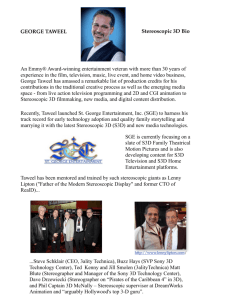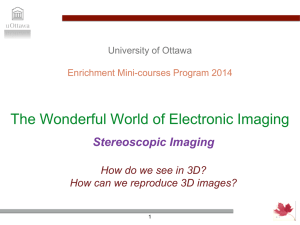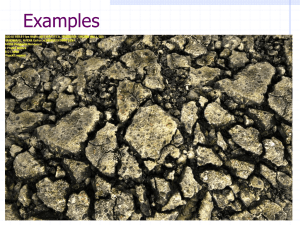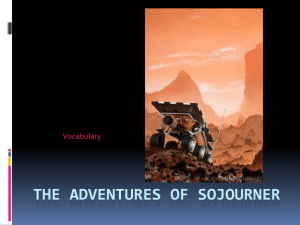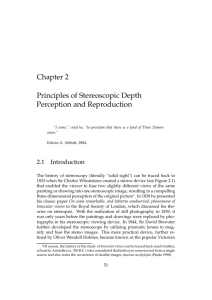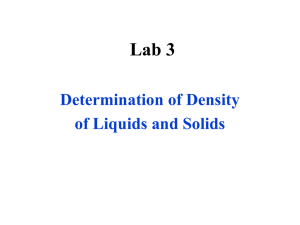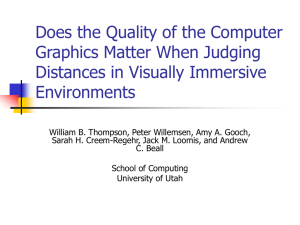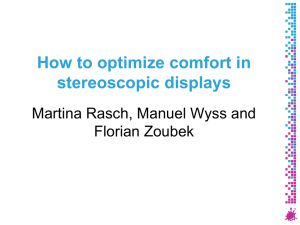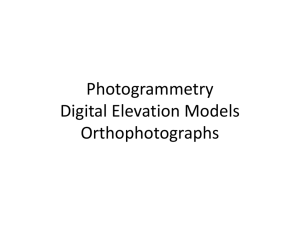05 Avid 3D解决方案
advertisement
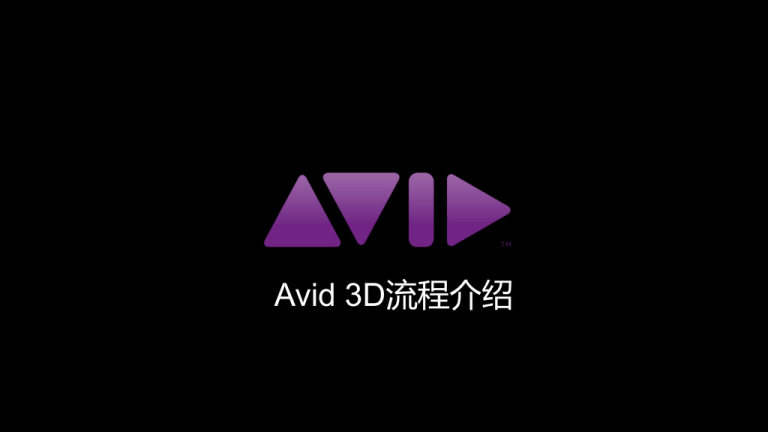
Avid 3D流程介绍 MC 6.0支持Stereoscopic 3D –整体介绍 • 使得3D制作和2D制作一样简单, 3D创新的剪辑流程 • 实时的混编3D, 2D 以及不同的帧速率 • 先进的全套3D修复工具 – 针对3D原始素材的空间位置颜色等校正 – 时间线上的特效,字幕 Stereoscopic 3D • 深度和左右画面校对工具 • 支持双路HDSDI 同时采集, 监看和输出。也支持基于文件的采集 • 新的 Nitris DX 3D 选件卡 • 全新的AAF输出Metadata • 支持输出文件格式 • 支持第三方硬件 2 Stereoscopic 3D – 系统安装/不同选择 • 纯软件系统 – 第二个显示器上全屏播发 – 支持3D Vision (只支持 PC ) – 实时的性能取决于机器的性能 • 当前的DX 硬件系统 – 只支持无压缩的项目 – 如果是压缩格式需要采集2倍的时间 – 一半的生成速度因为只有一个编码模块 • DX 3D 硬件系统 – 支持压缩的和无压缩的双路基带信号采集(2xDNx 2xAVC I) – 2个编码模块可以全速的使用硬件DNxHD渲染 • 使用第三方硬件的系统 – 所有第三方的硬件在当前版本只支持帧兼容的方式 3 Stereoscopic 3D – 纯软件的方式 4 Stereoscopic 3D – 硬件配置 NOTE: NitrisDX HDMI output is v1.3 so although it allows Frame Compatible output it doesn’t indicate the 3D format to the monitor 5 Stereoscopic 3D • 立体文件支持: – 帧兼容模式 Side by side Right Left – 帧兼容模式Over/ under Left Right – 全帧模式 Left Right 6 Stereoscopic 3D 项目创建时对于3D的支持 • 创建不同的3D项目 7 Stereoscopic 3D – 基带信号采集设置 采集设置 基带信号采集: • 在立体项目中选择素材的类型 8 Stereoscopic 3D – 文件夹的属性选项 • 文件夹的属性选项 9 Stereoscopic 3D – 创建立体素材 通过主素材创建立体素材 • 每个立体文件支持5个主素材. (左眼,右眼,上下,左右,普通的2D素材 ) • 选择主素材创建立体素材 • 使用图中命令 “Create Stereoscopic clips…” 选中素材右键. 10 Stereoscopic 3D –立体监看 右键点击源 和录制窗口 © Avid 2011 Avid confidential and proprietary information – Please do not copy, forward, redistribute, or publish 11 Stereoscopic 3D –立体监看 S3D效果安全阀值 左右眼画面超过 了安全阀值 左右眼画面在安 全阀值之内 12 Stereoscopic 3D – 立体效果的修复 • 修复颜色错误 选择左眼做颜 色校正 13 Stereoscopic 3D – 立体效果的修复 • S3D Spatial Alignment 特技 – Vergence (HIT) – 可以左右画面同时调整,也可以选择 锁住一个画面(比如:主导画面),调整另一个的画面 14 Stereoscopic 3D – 立体效果的修复 S3D Spatial Alignment: Vergence – set depth position – converge on the ball (= zero parallax). 3D display -ve Parallax 0 +ve Zero Parallax +ve Parallax Cinema Projection 15 Stereoscopic 3D – 立体效果的修复 S3D Spatial Alignment: Vergence – set depth position – converge on the dog -ve 3D display Parallax 0 +ve -ve Parallax Zero Parallax +ve Parallax Cinema Projection 16 立体窗口出错 使用 floating window 修复 No violation Window violation on smiley Floating window - Mask applied to left eye, left edge Try moving your cursor around on screen to ‘feel’ the depth of the smiley in each example 17 Stereoscopic 3D – S3D 特效介绍 • Stereoscopic 专用特效 Effect Description S3D Spatial alignment Allows you to realign left and right eye images using translation, scaling, shearing or rotational controls. This effect contains alignment tools as well as the Vergence and Floating Window effects. S3D Vergence Allows you to adjust the horizontal disparity between the two eyes. This is often known as Horizontal Image Translation (HIT) S3D Floating Window S3D Depth Transition Allows you to crop out an unwanted area of either the left or right eye image. For example, cropping out edge violations that are visible in one eye but not the other. When transitioning from one clip to another, this effect allows you to adjust the depth on each clip for a seamless transition. 18 Stereoscopic 3D – 添加特技 S3D Depth Transition S3D Depth Transition • Remember: every edit causes the viewer to re-fuse the 3D image sequence. • Longer shots and less cuts are desirable in 3D. Some directors and audiences are used to quick edits e.g. Football match, perhaps its time to slow things down again? Use 5 sec cuts as a absolute minimum. • Depth Continuity is important too, the depth bracket of out/in shots MUST overlap. • You can't cut 3D to/from anywhere, otherwise the 3D effect is discontinued with a break in belief for the audience and maybe discomfort with “double vision” too. 19 Stereoscopic 3D – 添加特技 S3D Depth Transition S3D Depth Transition Active Depth Cuts: When a depth cut is required E.g. When shot changes from one with negative parallax (out of screen) to another with all positive parallax (all behind screen) then create a moving depth cut: Cinema Plan view Screen R L L R CUT? 20 Stereoscopic 3D – 添加特技 S3D Depth Transition S3D Depth Transition Active Depth Cuts: When a depth cut is required E.g. When shot changes from one with negative parallax (out of screen) to another with all positive parallax (all behind screen) then create a moving depth cut: Change the convergence of the outgoing shot to a neutral depth just before the edit and start the incoming shot at the same depth before re-converge the shot to its original depth position. Keep the changing depth speed constant across the cut and slow enough just not to be noticed. The neutral depth will most likely be zero parallax at screen depth but doesn't have to be. Cinema Plan view Screen R L Cinema Plan view Screen R L CUT R L L R 21 Stereoscopic 3D – 添加字幕或者图片 图片,字幕 These can be tricky, especially for live 3D production, eg sport. Remember depth continuity. Graphics, captions etc should be placed unobtrusively and NOT cause occlusion. The obvious solution is often to put the graphic in negative parallax, closer than any action, but for say subtitles this is not subtle. For subtitles animated positioning may be required plus depth tracking to match the point of interest and scaling to track with depth. Screen Screen 2D Title sits at zero parallax (screen depth) and occludes smiley creates edge violation 3D Title brought closer than any other object, so doesn’t create violation 22 Stereoscopic 3D – 字幕的3D调整 添加字幕到立体素材上 • Titles or other graphic objects applied in a stereoscopic project have vergence control to allow you to position the title in Z-space or depth. Remember to keep the Title within the Depth Budget. • NOTE Titles for stereoscopic projects must be created in the Avid editing application. You cannot import them from 3rd-party applications. • Use Title Tool or Marquee to create your S3D Title • You can also promote this title to a 3D effect by clicking the 3D Promote button. This will give you additional features like 3D borders, drop shadow, page curls, smooth curve movement, and rotation. 23 Stereoscopic 3D – 通道图层的3D调整 • 通道图层也可以调整其3D效果 24 Stereoscopic 3D – 输出 立体项目输出 • You can output a stereoscopic sequence to a baseband device (such as a tape deck or disc recorder), or you can export the sequence to a file format such as QuickTime. NOTE: If you have any standard (non-stereo) material in the sequence, it will use the same image for both the left and right eye. Stereoscopic 项目格式 例如 QT .mov 输出 Full: Both eyes exported at full resolution (No QT Ref support) Two files exported: Video_L.mov and Video_R.mov Side-by-side: Frame compatible Single file created: video_SS.mov Over/Under: : Frame compatible Single file created: video_OU.mov Leading eye, Left eye only, Right eye only: Single file created: video.mov • For Baseband video the output format is primarily governed by the Stereoscopic Project Format, however as we have seen this can be overridden by the Video Output tool • You can also export your sequence to another system for finishing. Avid editing applications can export an AAF, ALE, or EDL file that contains the editing information (metadata) for the selected sequence, along with the video and audio media files for the master clips within the sequence. 25 Stereoscopic 3D – 输出 • 元数据输出 – 通过AAF输出元数据文件 • All of the information about the source attributes, stereo clip attributes and effects attributes are present in this file – We will look to see if the AAF toolkit can be extended to provide 3rd parties access to our stereo parameters in the combiner effect. – We will also provide a way for 3rd parties to create the S3D group, channel and other information in the mono master clips and stereo clips 26 谢谢大家!
